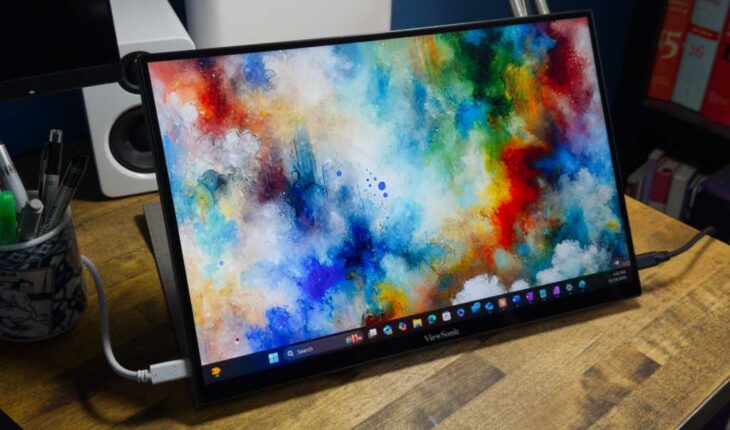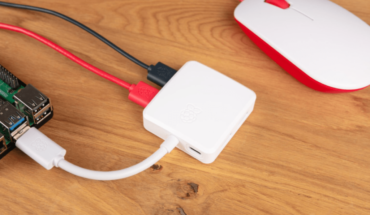Expert’s Rating
Pros
- Fabric cover converts into stand that supports landscape and portrait orientation
- USB-C ports deliver up to 65 watts of USB Power Delivery
- Touchscreen feels responsive in general use
- Passive stylus is included
Cons
- Touchscreen latency is noticeable when using the stylus
- Color performance doesn’t stand out
- Sticks to 60Hz refresh rate, doesn’t have Adaptive Sync
Our Verdict
The Viewsonic TD1656-2K is a portable touchscreen monitor with a sharp image and included passive stylus, but it’s better in Excel than your favorite photo editor.
Price When Reviewed
This value will show the geolocated pricing text for product undefined
Best Pricing Today
Price When Reviewed
$349.99
Best Prices Today: Viewsonic TD1656-2K

$349.99

$349.99

$349.99

$349.99
I don’t know about you, but I always prefer my computer to have a touchscreen. While I don’t constantly reach up and touch the monitor, there are situations where it’s a handy alternative to using the mouse. The ViewSonic TD1656-2K tries to fill that role, offering a portable touchscreen monitor compatible with both Windows and MacOS.
ViewSonic TD1656-2K specs and features
The ViewSonic TD1656-2K’s display panel specifications aren’t unusual for a 16-inch portable monitor. It has a 16:10 aspect ratio, a native resolution of 2560×1600, and an IPS LCD display panel with a refresh rate of 60Hz. There’s no adaptive sync and HDR is not supported.
- Display size: 16-inch 16:10 widescreen
- Native resolution: 2560×1600
- Panel type: IPS LCD 8-bit
- Refresh rate: 60Hz
- Adaptive sync: None
- HDR: No
- Ports: 2x USB-C with DisplayPort Alternate Mode and up to 65 watts Power Delivery
- VESA mount: No
- Speakers: 2x 2-watt speakers
- Price: $349.99 MSRP
Dig into the details though, and the display’s purpose stands out. It has a capacitive 10-point multi-touch screen, which you can manipulate with your fingers or with the passive stylus that is included in the box. The monitor also has two USB-C ports, both of which support video input and up to 65W of Power Delivery in both directions.
The TD1656-2K lists support for both Windows 11 and Mac. I spent most of my time with it connected to a PC laptop but also connected it to a Mac Mini to confirm that the touchscreen functioned (it did).
Further reading: See our roundup of the best portable monitors to learn about competing products.
ViewSonic TD1656-2K design
The ViewSonic TD1656-2K’s design is familiar from the front, with slim bezels on three sides and a slightly thicker chin on the bottom. Around the back you’ll find an expanse of silver metal. The shade of silver used by ViewSonic is arguably a bit too light to follow current trends (gunmetal and black shades seem in vogue right now), but it looks professional.
A fabric-covered display stand and cover ships with the monitor. Like the display itself, it looks professional but not trendy. It’s a semi-rigid cover that provides good protection from scratches or moderate falls. It doesn’t fully enclose the monitor, however, so it may still allow objects to wedge in between the case and the display.
When it comes time to use the monitor, you’ll have to fold the display stand into a desired position and attach the monitor to the stand magnetically. I found it a bit confusing at first, as it’s not immediately clear how the display should fold, and the manual offered no help.
Once I was comfortable using it, however, I discovered the stand works well. It supports several different viewing angles, from nearly upright to significantly reclined, and can also be used in portrait orientation, which is not common for any portable monitor stand.

Matthew Smith / Foundry

Matthew Smith / Foundry
ViewSonic TD1656-2K connectivity
The ViewSonic TD1656-2K relies on two versatile USB-C ports. Both support DisplayPort, which means either can be used to connect a PC to the portable monitor.
The USB-C ports also support up to 65 watts of Power Delivery in both directions. This is an uncommon feature for a portable monitor, as most only support enough Power Delivery to power the monitor itself.
It opens up some new connection options. When using the TD1656-2K with a laptop, for instance, you can connect USB-C power to the monitor and then connect the monitor to the laptop to charge the laptop while it inputs video to the monitor. That’s not possible with many portable monitors, since their Power Delivery is limited.
ViewSonic TD1656-2K features
Touch is, of course, the ViewSonic TD1656-2K’s headline feature. It has a 10-point capacitive touchscreen layered beneath a smooth, glossy panel. The touchscreen felt responsive and showed no issues with mistaken or missed inputs. I found the touchscreen especially useful with multi-touch gestures, like Windows’ five-finger pinch to close all apps.
The monitor also ships with a passive stylus. The stylus is stubby, and the tip is curved with a plastic protector that prevents it from scratching the display’s surface. Even so, I found it comfortable to hold and use. It doesn’t need power, so it’s light and never needs to be charged.
The ViewSonic TD1656-2K’s pair of 2-watt speakers can fill a small office with sound and audio quality, though modest, is clear and mostly avoids distortion.
While the touchscreen does work well in general use, it’s not perfect for creative work. The passive stylus felt comfortable in my hand, but touch input includes some latency. Though not readily noticeable when using touch to navigate apps with your fingertips, it’s obvious when using the stylus to draw in Affinity Photo, Photoshop, Paint, and similar apps. There are also no buttons or extra features. It’s a simple, passive stylus, and that’s it.
Even so, the stylus is fine for less demanding users. I prefer to use a touchscreen, when it’s available, for some photo touchups. The ViewSonic TD1656-2K felt like a good fit for my occasional editing needs. If you’re an aspiring or professional digital artist, however, the latency could be frustrating.

Matthew Smith / Foundry
The on-screen menu is controlled with the power button and volume buttons on the monitor’s right flank. The text is small, but the controls are easy to use. That, however, is in part because of the lack of options. Users can adjust brightness, contrast, volume, the audio mode, and that’s about it.
Speaking of audio, the monitor has a pair of 2-watt speakers that perform better than most. Maximum volume is high enough to fill a small office with sound and audio quality, though modest, is clear and mostly avoids distortion. There’s no bass, so the speakers are a bad choice for entertainment, but they work for listening to a podcast or having chill tunes on in the background. That’s more than can be said for most portable monitors.
ViewSonic TD1656-2K SDR performance
The ViewSonic TD1656-2K’s $349.99 MSRP is towards the upper end of pricing for portable monitors, but most of the added cost goes towards the touchscreen and USB-C connectivity with up to 65 watts of Power Delivery. The display panel itself is a 16-inch IPS display with a 16:10 aspect ratio and resolution of 2560×1600.

Matthew Smith / Foundry
ViewSonic comes out swinging with a maximum brightness of 381 nits. That’s much higher than typical for a portable monitor, and it helps the display remain usable in a wide variety of situations, including rooms with bright lighting that can’t be dimmed or turned off (like, say, a corporate bullpen). The display is glossy though, so glare can still be an issue.

Matthew Smith / Foundry
Contrast is also a strength for the TD1656-2K, though it depends on your perspective. Most portable monitors have a similar IPS display panel. Compared to such peers, the TD1656-2K’s measured contrast ratio of 1620:1 is better than average and provides an attractive image.
However, as the ViewSonic VX1655-4K-OLED shows, OLED portable monitors are in a different league. They provide a more immersive image with better depth and shadow detail in dark scenes. To be fair to the TD1656-2K, however, only a few portable OLED touchscreens exist, and they’re very expensive (around $500).

Matthew Smith / Foundry
Color gamut unfortunately proves a problem for the TD1656-2K. It delivers just 99 percent of sRGB and 76 percent of DCI-P3. These are low figures, coming ahead of only the Azorpa A1 Gamut, a budget portable monitor that’s often sold for less than $150.
The TD1656-2K’s modest color gamut means it literally displays fewer colors overall, and that results in a less alluring look. It’s not really a problem if you’re in Excel or browsing Threads, of course, but more obvious if you want to edit photos or watch YouTube.

Matthew Smith / Foundry
Color accuracy works more to Viewsonic’s favor. While the TD1656-2K’s color accuracy is not the best we’ve tested, it’s certainly more than enough to deliver a lifelike, realistic image.
The TD1656-2K also did well enough in gamma and color temperature. It achieved a gamma curve of 2.3, which is slightly off our target of 2.2. This means the image appears a tad darker than it should, but not by much. Color temperature came in at 6400K, off the target of 6500K, which means the image is ever-so-slightly warmer than ideal.
Sharpness is a strength. The TD1656-2K’s resolution of 2560×1600, which works out to around 189 pixels per inch (PPI). That’s better than a 27-inch 4K monitor, which provides 163 PPI, and competitive with most high-end Windows laptops. The monitor looks sharp even when viewing small, high-contrast text.
The ViewSonic TD1656-2K’s overall image quality is fine but has caveats. It’s not competitive with most portable monitors sold in the same price bracket, though it makes up for that by including a touchscreen
ViewSonic TD1656-2K HDR performance
HDR is not supported on the ViewSonic TD1656-2K. While that might seem a bit disappointing, it’s for the best, as portable monitors have limitations that make them a bad fit for HDR. It mostly comes down to brightness. Higher brightness means higher power draw, which isn’t a great fit for a portable monitor’s use case.
ViewSonic TD1656-2K motion performance
Motion performance isn’t a priority for the ViewSonic TD1656-2K, either. It has a refresh rate of 60Hz and does not support Adaptive Sync for smooth frame pacing. That makes the monitor a bad choice for fast-paced games, as significant motion blur can detract from the action, and you’ll need to use V-Sync to avoid unsightly frame tearing.
While I understand the TD1656-2K is not meant for gaming, I find the lack of a higher refresh rate a bit frustrating. A portable touchscreen monitor is arguably an ideal use case for a 120Hz refresh rate, as it will help the display look and feel more responsive. Sticking with 60Hz is a minor disappointment forgiven only by the fact most other portable touchscreens make the same choice (though a few companies, like Uscreen, offer both).
Should you buy the ViewSonic TD1656-2K?
Buying the TD1656-2K nets you a bright display, a responsive touchscreen, an acceptable stylus, and a semi-rigid fabric cover that doubles as a stand and supports use in both landscape and portrait orientation. The monitor also includes two USB-C ports with up to 65 watts of Power Delivery, which provides extra flexibility in how the monitor is connected. The monitor’s color performance disappoints, however, and its motion performance is a poor fit for gaming.
Ultimately, the ViewSonic TD1656-2K is a portable touchscreen monitor that’s better in a corporate bullpen than a home office or studio.





